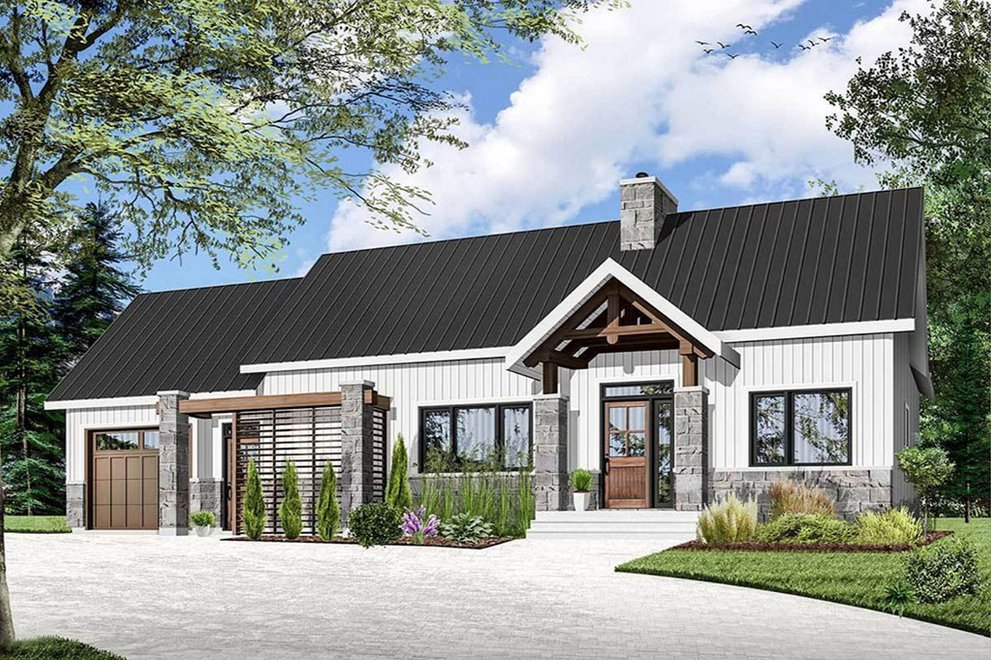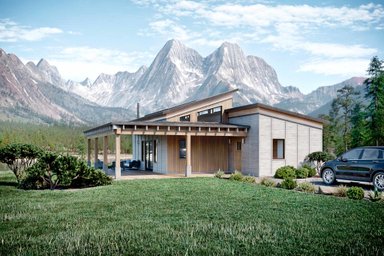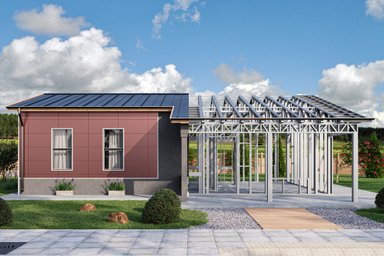Building
your home is likely to be the biggest investment that you’ll make. Make your
dream home a reality by saving money in smart ways and avoiding costly building
mistakes with these 12 money-saving tips from some of Houseplans.com’s favorite design and construction experts.

1. Know how you use your living space.
One of the smartest ways to save money when building your home is to first understand how you and your family use your living space, because good designers and builders are going to ask you about this at the beginning of the project.
“I start by looking at the family’s utility bills and asking about their passions,” says Steph Nelson, national sales director for Nelson Design Group, which designed plan 17-2480 above. Do you love the outdoors? Do you want to drink your morning coffee on the patio or watch the sunset there? Does someone in your family have a passion for cooking, making the kitchen a major focal point of your home? Knowing how you use your living space will help you build a home that better fits the way you live.
2. Choose your lot carefully.
Your lot can make or break you, says Todd Jenkins, Vice President Custom Division, at the design firm of Frank Betz Associates. “You want a gently sloping lot for a basement or a nice flat lot for a slab or crawl foundation,” Jenkins says.
Designer Jason Breland at House Plan Zone agrees. “While you may think you’ll save money buying a sloping lot, any savings will likely be negated by costly site prep and necessary additional foundation materials,” he says.
Read more tips about choosing a lot here.
3. Consider climate, sun orientation, and neighborhood.

Before you buy a lot, Nelson recommends understanding the climate in your area and the orientation of the sun on your lot because these factors will affect what you can build and where. For example, if you’re in a cooler climate, you don’t want windows or door on the home’s northern exposure because the house will lose heat through them in the winter. And if you want to put solar panels on your roof, you need a simplistic roof line (like plan 430-164 above) and lots of southern exposure.
In addition, Breland suggests researching the area your lot is in (the school system, crime rates, resale values, etc.). “There’s nothing worse than building your dream home on a lot you bought for a great price, only to realize after construction the reason why it was such a great deal,” he says.
4. Shop for a builder.
Shop around before committing to a builder. Check references, go look at past projects, get everything in writing, and get multiple bids before making your selection. “It may be tempting to hire your cousin’s best friend’s uncle for the ‘friends and family’ discount, but you get what you pay for, and the lowest bid may not always be the best,” Breland says. Jenkins agrees. “Always make sure everything is included in the price,” he says. “The cheapest guy could become the most expensive if he has left out items that were supposed to be in the quote.”
Read more tips on finding a builder here.
5. Avoid being your own general contractor.
Unless you’re a licensed builder, architect, or home designer, don’t try to build your home yourself—hire a licensed general contractor. While you may think you can save 10 to 15 percent, time is also money, and subcontractors won’t be as loyal to you as to the builders who give them the bulk of their work. You might wait weeks or months for work to be done, run the risk of a potential lawsuit if building regulations aren’t followed, and have no one to fix big mistakes like a toilet plumbed and installed in the wrong place. Plus, when you hire a builder, they can do reference and background checks on contractors, ensure that they have insurance (including workers’ compensation insurance), and see that lien wavers are signed after work is completed to prevent your being sued or having a lien placed on your house.
6. Compare bids from lenders.
Saving even .5 percent in interest over the course of a 30-year mortgage can keep thousands of dollars in your pocket. It’s also a good idea to pick your lender and get pre-approved before you choose your design, so that you know how much home you can afford to build.
Read more about how to secure a construction loan.
7. Choose a pre-designed plan.

Enjoy a smoother building process and avoid costly mistakes on the job site by selecting a pre-designed home plan like plan 938-90 above. However, before you buy the plan, talk with your builder to verify how much house you can afford. If you budget is for a 2,000-square-foot home, don’t purchase a 2,500-square-foot plan thinking that you can cut costs to afford it; you’ll end up wasting money on plans you can’t use. In addition, sticking to your budget and building a smaller house can free up dollars to invest things like in better insulation or higher-quality windows and doors. Another way to save money is to avoid extra unheated square footage by opting for a two-car garage instead of a three-car garage.
And finally, if you’re going to make modifications to your plans, have a professional service make them rather than doing change orders on the jobsite, which builders charge a premium price for.
Learn much more about plan modifications here.
8. Don’t make your home too unique.
While everyone wants their home to be unique in some way, keep resale value in mind, too. Remember, life happens, and if you end up moving at some point, a home that is custom designed for your needs might not appeal to potential buyers.
9. Shop for materials.
Most builders offer allowance for fixtures, appliances, and finishes. Breland advises doing your homework and pricing these items before buying them. Impulse buys at the home improvement store will wreak havoc on your budget. You can find great deals online and avoid sales tax in some cases. Also, avoid custom (meaning more expensive) finishes. Choosing readily available products and fixtures that are cheaper like pre-fabricated shower units and cabinetry are good ways to save. With all the variety in today’s home products, you’re not likely to sacrifice individuality for cost.
Also consider checking out one of Habitat for Humanity's ReStores, which sell new and used building materials at steep discounts to fund the nonprofit.
10. Plan for the future.
Save money by planning for spaces you’ll want in the future. Consider roughing out plumbing and electrical in common walls for an in-law unit or bonus room you can add later. And, if you’re handy, you can save even thousands by finishing the space yourself later on.
11. Do some work yourself if you are knowledgeable.
This can save you money if you have construction experience. However, “if your only experience is binge-watching HGTV and DIY network, then this might not be the best money-saving tip,” Breland says. Know your limitations and be humble enough to know when to call a professional. In addition, consider planting your own landscaping, which can save on labor costs.
12. Communicate with your builder.
Many of the problems experienced in the process of building a home can be attributed to a lack of communication. Don’t be afraid to ask questions and go over construction elements with your builder before they start. It’s always cheaper to get it right the first time rather than to tear something out and start over.
Also, did you know that your builder can qualify for discounts on home plans? Send them here to find out more!
Shop affordable house plans here.

1. Know how you use your living space.
One of the smartest ways to save money when building your home is to first understand how you and your family use your living space, because good designers and builders are going to ask you about this at the beginning of the project.
“I start by looking at the family’s utility bills and asking about their passions,” says Steph Nelson, national sales director for Nelson Design Group, which designed plan 17-2480 above. Do you love the outdoors? Do you want to drink your morning coffee on the patio or watch the sunset there? Does someone in your family have a passion for cooking, making the kitchen a major focal point of your home? Knowing how you use your living space will help you build a home that better fits the way you live.
2. Choose your lot carefully.
Your lot can make or break you, says Todd Jenkins, Vice President Custom Division, at the design firm of Frank Betz Associates. “You want a gently sloping lot for a basement or a nice flat lot for a slab or crawl foundation,” Jenkins says.
Designer Jason Breland at House Plan Zone agrees. “While you may think you’ll save money buying a sloping lot, any savings will likely be negated by costly site prep and necessary additional foundation materials,” he says.
Read more tips about choosing a lot here.
3. Consider climate, sun orientation, and neighborhood.

Before you buy a lot, Nelson recommends understanding the climate in your area and the orientation of the sun on your lot because these factors will affect what you can build and where. For example, if you’re in a cooler climate, you don’t want windows or door on the home’s northern exposure because the house will lose heat through them in the winter. And if you want to put solar panels on your roof, you need a simplistic roof line (like plan 430-164 above) and lots of southern exposure.
In addition, Breland suggests researching the area your lot is in (the school system, crime rates, resale values, etc.). “There’s nothing worse than building your dream home on a lot you bought for a great price, only to realize after construction the reason why it was such a great deal,” he says.
4. Shop for a builder.
Shop around before committing to a builder. Check references, go look at past projects, get everything in writing, and get multiple bids before making your selection. “It may be tempting to hire your cousin’s best friend’s uncle for the ‘friends and family’ discount, but you get what you pay for, and the lowest bid may not always be the best,” Breland says. Jenkins agrees. “Always make sure everything is included in the price,” he says. “The cheapest guy could become the most expensive if he has left out items that were supposed to be in the quote.”
Read more tips on finding a builder here.
5. Avoid being your own general contractor.
Unless you’re a licensed builder, architect, or home designer, don’t try to build your home yourself—hire a licensed general contractor. While you may think you can save 10 to 15 percent, time is also money, and subcontractors won’t be as loyal to you as to the builders who give them the bulk of their work. You might wait weeks or months for work to be done, run the risk of a potential lawsuit if building regulations aren’t followed, and have no one to fix big mistakes like a toilet plumbed and installed in the wrong place. Plus, when you hire a builder, they can do reference and background checks on contractors, ensure that they have insurance (including workers’ compensation insurance), and see that lien wavers are signed after work is completed to prevent your being sued or having a lien placed on your house.
6. Compare bids from lenders.
Saving even .5 percent in interest over the course of a 30-year mortgage can keep thousands of dollars in your pocket. It’s also a good idea to pick your lender and get pre-approved before you choose your design, so that you know how much home you can afford to build.
Read more about how to secure a construction loan.
7. Choose a pre-designed plan.

Enjoy a smoother building process and avoid costly mistakes on the job site by selecting a pre-designed home plan like plan 938-90 above. However, before you buy the plan, talk with your builder to verify how much house you can afford. If you budget is for a 2,000-square-foot home, don’t purchase a 2,500-square-foot plan thinking that you can cut costs to afford it; you’ll end up wasting money on plans you can’t use. In addition, sticking to your budget and building a smaller house can free up dollars to invest things like in better insulation or higher-quality windows and doors. Another way to save money is to avoid extra unheated square footage by opting for a two-car garage instead of a three-car garage.
And finally, if you’re going to make modifications to your plans, have a professional service make them rather than doing change orders on the jobsite, which builders charge a premium price for.
Learn much more about plan modifications here.
8. Don’t make your home too unique.
While everyone wants their home to be unique in some way, keep resale value in mind, too. Remember, life happens, and if you end up moving at some point, a home that is custom designed for your needs might not appeal to potential buyers.
9. Shop for materials.
Most builders offer allowance for fixtures, appliances, and finishes. Breland advises doing your homework and pricing these items before buying them. Impulse buys at the home improvement store will wreak havoc on your budget. You can find great deals online and avoid sales tax in some cases. Also, avoid custom (meaning more expensive) finishes. Choosing readily available products and fixtures that are cheaper like pre-fabricated shower units and cabinetry are good ways to save. With all the variety in today’s home products, you’re not likely to sacrifice individuality for cost.
Also consider checking out one of Habitat for Humanity's ReStores, which sell new and used building materials at steep discounts to fund the nonprofit.
10. Plan for the future.
Save money by planning for spaces you’ll want in the future. Consider roughing out plumbing and electrical in common walls for an in-law unit or bonus room you can add later. And, if you’re handy, you can save even thousands by finishing the space yourself later on.
11. Do some work yourself if you are knowledgeable.
This can save you money if you have construction experience. However, “if your only experience is binge-watching HGTV and DIY network, then this might not be the best money-saving tip,” Breland says. Know your limitations and be humble enough to know when to call a professional. In addition, consider planting your own landscaping, which can save on labor costs.
12. Communicate with your builder.
Many of the problems experienced in the process of building a home can be attributed to a lack of communication. Don’t be afraid to ask questions and go over construction elements with your builder before they start. It’s always cheaper to get it right the first time rather than to tear something out and start over.
Also, did you know that your builder can qualify for discounts on home plans? Send them here to find out more!
Shop affordable house plans here.






